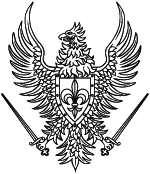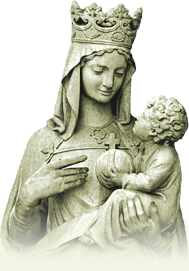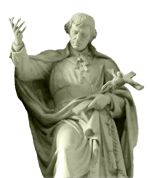Arts
Conspiracy in arts?
Orlando Fedeli
When it comes to conspiracy in History, there are some people who, even before analyzing the question, have the creeps and get angry, considering this issue an absurd and the hypothesis impossible or crazy.
However, we just have to study History a little deeper to figure out that this issue is not absurd and that the hypothesis is, in fact, a sound thesis.
In this article we will analyze just some texts of serious authors, which either admit that there is already a conspiracy in History, for a long time, made by artists – affiliated to Gnosis – or give us safe data that points to this conspiracy.
As we know, Gnosis is the heresy that is behind of all false religions, and it is the great nemesis of the Catholic Church in History. We can say that it is the Heresy by excellence.
We could get back to the beginning of the Middle Ages. However, in this article, we will take a look in the ages beginning with the Renascence, following through the origins of Romanticism, until we get to the Modern Art, in the XX century.
To start with, and to prove the influence of the Gnosis in the Renascence, it is convenient to know the works of the Florence Platonic Academy that, leaded by Marcilio Ficino, have a huge influence in the mainstream artists of those times, like Sandro Botticelli, Leonardo da Vinci and Michelangelo.
We can find important data about this issue in the book of D. P. Walker, "Spiritual and Demonic Magic from Ficino to Campanella" (University of Notre Dame Press, Notre Dame – London, 1969). In this work, he demonstrate how a neo-platonic, hermetic and magic line of thinking has dominated the thoughts of the main humanists and artists of the Renascence, imposing to them a gnostic cosmic vision and, therefore, anti catholic.
At the same time, Pico de Mirandola, on his turn, threw the very first seeds of Christian Cabalism, in
On this same subject, confirming the same historic pieces of information, it was published a book with comments of the major experts in this matter (Gershom Scholem, Ernst Benz, Serge Hutin et allii, Kabbalistes Chrétiens, Albin Michel, Paris, 1979). This book was part of the collection Cahiers de L´Hermétisme, edited by Antoine Faivre and Frédéric Trinstan.
Another work that shows the gnostic features of the main works of art from Renascence’s artists is the precious book by Edgar Wind, Pagan Mysteries in the Renaissance (Faber and Faber,Londres 1968). Wind shows us how great artists of Renascence, besides using Christian themes, used a universe of codes which allow the initiated in Gnosis and hermeneutic to read them, under an anti-catholic perspective.
An analysis of these works would extend pretty much this article, trespassing the boundaries that we propose to ourselves: to demonstrate briefly that there is a conspiracy that has dominated the arts in the West, beginning at the end of the Middle Ages.
Because of this, we will look closely to closer times, by citing particularly some trusted contemporary authors, who demonstrate and confess that this conspiracy exists, be that in Romanticism, or in Modern Art, the very schools which influence the mentality of our times the most.
Let us see then what Ladislao Mittner says about the origins of the Romantic Pietists.
"It is almost impossible to distinguish the Pietists from the many other religious sects of [their] time. Singular branches of the movement show themselves carsic phenomena: they appear, disappear, and, all of a sudden, reappear in another place, and the identity of the branch usually cannot be properly demonstrated”. (L. Mittner, Storia della Letteratura Tedesca – Dal Pietismo al Romanticismo (1700-1820), ed. Giulio Einaudi, Torino, 1975, p. 49).
In order to understand well the meaning of a Carsic phenomenon, we must explain that, in the Carsus – a limestone region of the former
This is like the action of Gnosis in History. It, like a Carsic river, appears all of sudden, and afterwards disappears mysteriously, and comes back to surface of History, as if it came from nothing, and thereafter disappears once again.
Like a hidden movement, which remains pulsing in the underworld of History, the Gnosis is behind all art, since the hermetic schools that informed the Renascence, until the modern art, passing through Romanticism:
"We can say that rules, since the Romanticism, a kind of pessimistic and sentimental dualism, similar to the gnostics’. It consists mainly in the sense that man is badly adapted to his own condition, he finds himself tortured, and he needs something else, as if he was a stranger to himself and to the world where he lives, as if his real nature were not there (in the world). We said that the gnostics are romantics; we could say, in the same way, that the Romanticism is gnostic” (Simone de Pétrement, Le Dualisme chez Platon, les Gnostiques et Manichéens, PUF, Paris, 1947, p.344).
This same author dare to say: "Judging by our literature, we entered a gnostic age".(S. de Pétrement, cited work, p.347).
G Gusdorf, in his capital work on Romanticism, says that “Romanticism is a gnostic Renascence; (...) Schelling is a gnostic, whose convictions are developing as he ages, and the same goes for Baader. The Naturphilosophie imposes gnostic codes to the scientific research. In France, following Saint Martin and de Fabre d’Olivet, Gnosis triumph in Ballanche’s writings; it sustains Victor Hugo’s poetic genius, it is present in Lamartine of the Visions and in the Nerval of the illuminates” (G. Gusdorf, Le Romantisme, Payot, Paris, 1982, 1983, 1993, p.512).
Among the limits of this short article, we cannot examine this issue thoroughly. If someone wants to go deep inside it, he could find great information relating Romanticism and Gnosis in the works of Ernst Benz, Les sources Mystiques de la Philosophie Romantique Allemande (Vrin, Paris, 1968), or yet in Auguste Viatte’s, Les sources occultes du Romantisme (Honoré Champion, Paris, 2 vol. 1979).
Let us see some significant confessions:
Starting with a quotation from an unsuspected and Nobel Prize of Literature winner author: Octavio Paz, who reveals us in his book Los Hijos del Limo something extraordinary, in the sense of something that nobody says and many try to hide.
"The analogy is a kingdom of the word as this verbal bridge which, without suppressing them, conciliates their differences and oppositions. Analogy appears in the same way among the primitives as in the great civilizations of the beginning of History, and reappears among the Antiquity’s Platonics and Stoics. It is developed in the medieval world and, ramified in several creeds and subterranean sects. It has converted since the Renascence into the secret religion, one can say, of the West: cabala, gnosticism, occultism, hermeticism. The modern poetry’s history, since Romanticism until our days, is inseparable of this stream of ideas and beliefs inspired by the analogy" (Octávio Paz, Los Hijos del Limo, Editorial Seix Banal, Barcelona, 1993, p. 102. Bolded and underlined ours).
And those who believe in the natural goodness of the man should have the creeps: There is, according the confession of a Nobel Prize winner, a secret religion that secretly rules the West for many centuries. And this secret religion is the old Gnosis, enemy of Catholicism.
Those that deny and swear that the conspiracy theories of History are fruits of delirious minds should be angry and creep in horror. If they swear that there is no conspiracy, either they ignore the true History, or they are accomplices of the conspiracy, and deny it, so that their works have better chances of success.
And Octávio Paz continues:
"The gnostics, cabalists, alchemists, and other marginal tendencies of XVII and XVIII centuries, influenced very deeply not just the German romantics, but Goethe himself, and his circle. We can say the same for the English, and of course, French Romantics. By its turn, the occultist tradition of XVII and XVIII centuries can be related with several libertine and socio-critical movements.
The belief in the universal analogy is tainted of eroticism: the bodies and the souls tie and untie themselves are ruled by the same law of attraction and repulsion that rule the conjunction and disruption of the stars and of the material substances. An astrologic eroticism and an alchemistic eroticism; as also a subversive eroticism: the erotic attraction breaks the social laws and ties the bodies without distinction of social level or hierarchy. The erotic astrology offers a model of social order founded in the cosmic harmony and opposite to the order of the privileges, to the power, and to the authority. The erotic alchemy, which is the union of contrary principles, the male and the female, and their transformation in another body, is a metaphor of the changes, separations, unions and convertions of the social substances (classes), during a revolution". (Octávio Paz, cited work, p.103).
Other serious studies confirm what Octávio Paz says. Look, for example, at Ronald D. Gray” work, Goethe, the Alchemist (Cambridge, at the University Press, 1952), as Antoine Faivre’s book, L’Ésotérisme au XVII ème Siècle (Séghers, Paris, 1973).
Therefore, we have no doubt that there has been an underground action, gnostic and occult, in arts and in History, along the last centuries.
We quote Fernando Pessoa, the great Portuguese poet, as a participant of this real gnostic conspiracy against the Catholic Church. In a little work about the Free-Masonry, Pessoa described himself as a “gnostic Christian, and therefore completely against all organized churches, and mainly, against the Church of Rome, faithful to the secret tradition of Christianity, which have close relations with Israel secret tradition (the Saint Cabala), and to the occult essence of the Free-Masonry." (Fernando Pessoa, Das Origens e Essência da Maçonaria e do seu contributo judaico, Ed. Princípio, São Paulo, 1993).
Fernando Pessoa, in another work, reveals all his hatred against the Church of Rome, by saying:
"The real patron of our Country is this shoemaker [the cabalist] Bandarra. Let us abandon
"We do not need
"Let us drive out, therefore, this roman element. If there must be some religion in our patriotism, let us take it from this patriotism. Fortunately we have it: Sebastianism”. (Fernando Pessoa, Portugal, Sebastianismo e Império" Publicações Europa e Império, Portugal, 1986, p 110-111).
And there would are have many more authors and artists we could cite. However, let us see what Octávio Paz has to say yet, very explicitly, in another work of his:
"Monnerot compared the history of modern poetry with the history of gnostic sects and with other adepts of occult tradition. This is true in both senses. It is undeniable that gnosticism and hermetic philosophy have influenced poets like Nerval, Hugo, Mallarmé, not mentioning poets of this century: Yeats, George, Rilke, Breton. On the other hand, each poet creates around himself little circles of initiates, in order that, without exaggerating, we can talk about secret society of poetry. These groups have had a huge influence and transformed our time’s sensibility. From this point of view, it is not false to claim that the modern poetry incarnated in history, not under full light, but as a nocturne mystery and a clandestine rite.” (Octávio Paz, Signos em Rotação, Ed. Perspectiva, São Paulo, 1996, p. 84. Bolded and underlined ours).
Even if there is no conspiracy of gnostic character in History, and therefore an anti-Catholic conspiracy, against
Nothing. Nobody comments it. Nobody practically talks about it. It may even be printed, but it is as if nobody has read, seen or heard it. There is just silence. A suspicious and proving silence that, in fact, conspiracy does exist.
Pay attention that, according to Octávio Paz’s claims, the sensibility of our times is the result of such conspiracy. And nobody comments it, as nobody contests what Octavio Paz said.
Just few days ago, we have had a polemic email exchange with a youth regarding Rock and Roll and its use to diffuse Satanism. He refused to accept a fact already confessed by the international Rock leaders, who say that this kind of music is part of a subversive and communist conspiracy.
Octávio Paz says something even more radical: all the sensibility of XX century was a result of a conspiracy that imposed to the world an absurd and gnostic art, which is called Modern Art.
The so-called Modern Art is plenty of gnostic sources and theory. Thus, Kandinsky e Paul Klee were gnostics and followers of Madame Blavatsky’s Theosophy. Mondrian followed the Theosophy of the magician Schoenmaker. The surrealism is openly gnostic.
André Breton, in one of his Surrealism manifests, wrote:
" It [the poetic intuition], finally, freed in the Surrealism, shows itself not just as assimilator of all known forms, but boldly creator of new forms – that means, in position of embracing all structures of the world, be manifested or not. It gives us the wire that conduct us to the way of Gnosis, as knowledge of supra sensitive Reality, ‘invisibly visible in an eternal mystery’”(André Breton, Do Surrealismo em suas Obras Vivas, In Manifestos do Surrealismo, ed. Brasiliense, São Paulo, 1985, p. 231).
Regarding the spirit of Modern Art, Anália Jaffé, disciple of Jung and diffuser of his cult, made the most important comment. This author claims that
"A great number of artists tried to trespass from the appearances to a reality of a second layer, or to the “spirit of the matter”, through a transmutation process of the objects – through fantasy, surrealism, through oniric images, by chance etc.” (...) “Art was transformed into mysticism”. (262) (...) “Art was submersed in the mystery of a spirit. This was an earthly spirit which the medieval alchemists used to call Mercury. Mercury is the symbol of the spirit that these artists sensed or looked for, behind the nature of things, ‘behind the appearance of nature’. Its mysticism is not Christian, for the spirit of Mercury is strange to the “heavenly” spirit. In fact, it was the old and tenebrous foe of Christianity that machined its path throughout art. We started to see here the true historic and symbolic meaning of the ’Modern Art’” (p.263).
“In its positive aspect, this spirit appears like an ‘spirit of nature’, whose creative power moves man, the things and the world. It is the “tectonic spirit” or earthly, which we mentioned several times in this chapter. In the negative aspect, the unconsciousness (of this same spirit) manifests itself as an evil spirit, with a destructive propulsion.”
"As we have already noticed, the alchemists personify this spirit as “the spirit of Mercury”, and called it very properly of "Mercurius Duplex" (or two faces Mercury, dual). In the religious language of Christianity, it is called devil" (P.267) (Anélia Jaffé, "O Simbolismo nas Artes Plásticas" in Carl G. Jung, O Homem e seus Símbolos, ed. Nova Fronteira,, Rio de Janeiro, ed original 1964, pp. 261 a 271).
So, this is the mystery unveiled.
There is an artistic conspiracy in our times that changed the sensibility of contemporary men. This conspiracy has a Gnostic, anti-Catholic and anti-Christian basis. The spirit that dominates it is called devil, as confesses Anália Jaffé
Contemporary writers, with a great deal of authority and non-suspicion, confessed everything that was said here.
However, if somebody repeats what they say, he is called paranoid with persecution mania, who sees the phantom conspiracies everywhere.
Great authors can confess that there is this anti-Catholic, gnostic and devilish conspiracy.
But poor of him who dares to repeat this!
Para citar este texto:
"Conspiracy in arts?"
MONTFORT Associação Cultural
http://www.montfort.org.br/eng/veritas/arte/conspiracaoarte/
Online, 23/12/2025 às 02:45:21h








